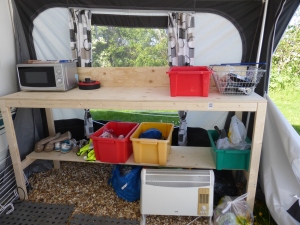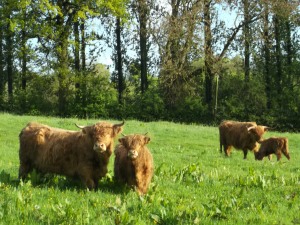Being an ecologist has many perks. OK, I often have to get up really early (sometimes 2am early!), but these early mornings often yield good fruits. Being out and about when the day is just stirring always feels like a treat to me – as if I’ve been granted a special gift of a morning to myself; just me and the animals all pottering about together doing our morning chores. This morning I found myself standing in a sparkling dew-tipped field with a gently curious family of Highland cattle – I love these placid creatures. I watched the mother licking her calf and could almost feel how comforting the rough touch would be to the little one. Witnessing such maternal care breaks down the barriers we impose between us and other mammals.
I was in the field to empty some newt traps in the hedgerow pond. It’s the great crested newt survey season, which first involves setting newt traps at dusk (made from 2-litre plastic bottles cut in half and the top end inverted, then impaled on a garden cane, the end of which is embedded in the pond floor so that the inverted neck of the bottle is below the water-line). As back-up search techniques you may also search the aquatic vegetation for their eggs or use a net to try and find them. Then, once darkness descends, you look for newts in the pond with a high-powered torch. Overnight, the curious newts may enter the inverted end of the bottle and are then apparently too stupid to find their way back out, even though it’s perfectly possible for them to do so. So we revisit the ponds in the early morning to check out our newt haul and let the dense little critters back into the water. By the way you need a Natural England licence to do this – yes, I possess a great crested newt handling licence – it’s a funny old world!
Great crested newts are protected by European law. We actually have loads of them in the UK, but we’re one of the last strongholds across Europe for this beautiful species, so we need to protect what we have. Not always popular with developers, as you can imagine, but if you were to see one in the flesh, it may persuade you why we need them in the world. They are truly spectacular – they have jet-black, grainy skin with a vibrant orange belly and orange and black striped feet. The courting male has a spectacular jagged crest and white stripe down his tail and the females are just, well, huge. To me they look primeval; left-overs from dinosaur days. In the water they are graceful, floaty, ethereal, shooting off in a flash when disturbed. In the hand they are fairly slow and stolid.
I unfortunately didn’t find any cresties this morning, but I did find this gorgeous male smooth newt – smaller than a crestie and covered with spots, with an evenly undulating crest rather than a jagged one. Their splendour when suspended in water, with crests aloft, doesn’t translate to when they’re in the hand looking all squat and slimy. Then their crest just flops, their spotty pattern dulls and they look like the kind of stupid creature that can’t find the exit they’ve just walked (or swum) through. But really, in the water they are something else. I will try and bring photos of this from a future haul.

Male smooth newt
Quick caravan life update – we had a very industrious bank holiday weekend (well, mostly Chris to be fair), which has resulted in a solution to our water issue (we now pump out of a 100 l water butt) and a great storage solution for the awning (see photo below), knocked up by Chris in an hour. My own contribution was the installation of solar-powered fairy lights over the awning roof, which don’t seem to work. Humph.

Neat and tidy, tidy and neat.

